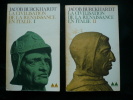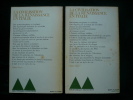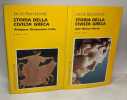81 books for « jacob burckhardt »Edit
-
Latest
Last month (4)
Last week (1)
-
Century
19th (7)
20th (35)
-
Countries
Belgium (5)
Denmark (3)
France (55)
Switzerland (18)
-
Syndicate
ILAB (39)
NVVA (6)
SLACES (6)
SLAM (26)
Topics
- Aesthetics (1)
- Architecture (1)
- Basel (2)
- Civilisation (3)
- Cooking (1)
- Europe (1)
- Fine arts (3)
- Geography (2)
- German literature (3)
- Germanic languages (8)
- Germany (1)
- Gold (1)
- Gothic (1)
- Greece (1)
- Guide books (1)
- Head edition (1)
- Helvética (2)
- History (25)
- History of art (1)
- Hugo victor (1)
- Italian (2)
- Italy (13)
- Jacob (80)
- Literature (3)
- Painting (1)
- Philosophy (1)
- Rubens (1)
- Sculpture (1)
- Sociology (1)
- Switzerland (2)
- Various (1)
Histoire de la civilisation grecque : Tome 1
Editions de l'Aire (15 octobre 2001)
Livre à l'état de neuf, très frais sans annotations ni défauts dissmulés.
Histoire de la civilisation grecque : Tome 2
Editions de l'Aire (15 octobre 2001)
Un pli sur premier plat sinon neuf.
Démétrios, le preneur de villes
Le Promeneur (23 janvier 1992)
Livre à l'état de neuf, très frais sans annotations ni défauts dissmulés.
La Civilisation De La Renaissance En Italie - traduction De h. Schmitt
Livre De Poche broché Bristol illustré 1966 299 pages en format 11 - 18 cm - illustration
Très Bon État
La civilisation de la renaissance en Italie. Tome 1et 2
Paris, Editions Gonthier, 1958, poche, broché, 232 & 230 pages. Bon état.
DER CICERONE. EINE EINLEITUNG ZUM GENUSS DER KUNSTWERKE ITALIENS
ALFRED KRÖNER VERLAG. 1925. In-12. Cartonnage d'éditeurs. Etat d'usage, Couv. légèrement passée, Coiffe en tête abîmée, Intérieur frais. 1044 pages. Frontispice en noir et blanc. Texte en allemand.. . . . Classification Dewey : 830-Littératures des langues germaniques
Classification Dewey : 830-Littératures des langues germaniques
LA CIVILISATION DE LA RENAISSANCE EN ITALIE.
LE CLUB DU MEILLEUR LIVRE. NON DATE. In-4. Cartonnage d'éditeurs. Etat d'usage, Couv. légèrement passée, Dos abîmé, Intérieur acceptable. 354 pages. Toile rouge, titre doré au dos, vignette en couleurs contrecollée sur le premier plat. Nombreuses photos et illustrations héliogravées en noir et blanc dans et hors texte. Auréoles sur les plats et tâche au dos. Traces sur les pages de garde.. . . . Classification Dewey : 909-Civilisation
Exemplaire n°3531 sur 2500. Classification Dewey : 909-Civilisation
UNE MATINEE CHEZ LE LIBRAIRE (RENCONTRE AVEC RILKE) suivi de SOUVENIRS DE RAINER MARIA RILKE
L'ANABASE 1994 Soft Cover New
TRADUCTION DE L'ALLEMAND PAR GUY FILLION D'UNE PART ET PASCALE ET PIERRE ROUSSEAUX D'AUTRE PART-DESSINS DE CHRISTIAN SERRANO-64 PAGES FORMAT 12 CM X 18,5 CM-(22C)
Die Zeit Constantin's des Grossen. - [REINTERPRETING GIBBON]
Basel, 1853. 8vo. A little later green hcloth w. simple handwritten paper title label to spine. Some leaves brownspotted. VII, (1), 512 pp.
First edition of the first publication of any of Burckhardt's books, his fist major publication, the important and influential ""The Age of ConstantinE the Great"".Burckhardt's ""The Age of Constantine the Great"" was the first work to describe an ""Age of Constantine"". It was also the first work of a series of cultural histories that Burckhardt had planned. The series was supposed to begin with the age of Pericles and end with that of Raphael, and that of Constantine became the first to appear. The work founded the basic structure of his other later cultural histories, namely representing what he considered the three great powers: state, religion and culture. Burckhardt eminently describes transitional periods and periods of crises, and this work deals with the transition from late pagan Antiquity to early Christian Middle Ages.The age of Constantine is here considered as the necessary transition from Antiquity to the Christian era and as such it is also understood as the basis of the culture of the Middle Ages. In opposition to the historians of his time, Burckhardt portrayed the Emperor Constantine negatively, as a calculating politician only concerned with preserving his own power, whose turn toward Christianity was purely speculative and driven by politics. He is thus portrayed as wholly unreligious and as having the sole goal of dominion. The work and the portrayal of Constantine caused the greatest controversies within religious and historical circles. The work became hugely influential and many later historians were inspired by both the controversial portrayal of Constantine, which they applied to other historical figures as well, as well as of Burckhardt's theories of the transition between the two eras. The Swiss historian of art and culture, Jacob Chrisoph Burckhardt (1818-1897), contributed seminally to the historiography of these two fields. He is considered the discoverer of the Renaissance, and with his later main work, ""Die Cultur der Renaissance in Italien"", he founded the study of thirteenth- to fifteenth-century Italy and thereby the historical study of the Renaissance, the society of which he dealt with all aspects of. In general, Burckhardt's works all constitute an original historical approach to the study of art, culture, social institutions etc. As a highly respected scholar of Greek civilization, Burckhardt, with his original historiographical approach, was highly admired by Nietzsche, who also attended his lectures. The two kept in contact and corresponded frequently. Like Nietzsche, Burckhardt was a great admirer of Schopenhauer, and he greatly opposed the Hegelian interpretations of history.""Outstanding among his (Burckhardt's) writings are, besides the books on Italian art and civilization, ""The Age of Constantine the Great"", 1853, in which he reinterpreted Gibbon, and the two posthumously published books..."" (PMM, p. 210).
Die Cultur der Renaissance in Italien. - [FOUNDING THE HISTORICAL STUDY OF THE RENAISSANCE - PMM 347]
Basel, 1860. 8vo. A little later green half cloth with a recent printed paper title-label to spine. Brownspotting to some leaves. Some underlinings and maginal annotations, all in pencil. Near contemporary annotations/description pasted on to verso of dedication-leaf. (4), 576 pp.
The scarce first edition of Burckhardt's main work, the groundbreaking work on the culture of the Renaissance, which helped found the historical study of this previously much overlooked era. "" ""The most penetrating and subtle treatise on the history of civilization"", in Lord Acton's words, ""a mere essay"", as Burckhardt himself called it, ""The Civilization of the Renaissance in Ittaly"" has, for more than a century, determined the general conception of thirteenth- to fifteenth-century Italy."" (PMM p. 210)This classic of Renaissance historiography is of the greatest importance to the development of the history of the Renaissance and of history of art and culture in general. More specifically, Burckhardt here establishes the fact that the Renaissance came first in developing the human individuality to the highest degree. He places the earliest signs of ""the modern European Spirit"" in Florence, which was a great contributing factor to the comprehension of this city as representing one of the highlights of European culture.The Swiss historian of art and culture, Jacob Chrisoph Burckhardt (1818-1897), contributed seminally to the historiography of these two fields. He is considered the discoverer of the Renaissance, and with his main work he founded the study of thirteenth- to fifteenth-century Italy and thereby the historical study of the Renaissance, the society of which he dealt with all aspects of. In general, Burckhardt's works all constitute an original historical approach to the study of art, culture, social institutions etc. As a highly respected scholar of Greek civilization, Burckhardt, with his original historiographical approach, was highly admired by Nietzsche, who also attended his lectures. The two kept in contact and corresponded frequently. Like Nietzsche, Burckhardt was a great admirer of Schopenhauer, and he greatly opposed the Hegelian interpretations of history.""... as in the case of other great historians such as Gibbon, Ranke, Macaulay, no criticism of details can detract from the powerful spell which Burckhardt's book has exercised upon such widely different writers as Ruskin, Nietzsche and Gobineau, as well as upon innumerable lovers of the most magnificent period of European history."" (PMM).Printing and the Mind of Man 347.
Jacob Burckhardt. La Civilisation de la Renaissance en Italie : Edie Kultur der Renaissance in Italiene essai. Traduction de H. sic pour L. Louis Schmitt revue... par R. Robert Klein
Le Livre de poche Broché D'occasion bon état 01/01/1966 302 pages
Le Cicerone guide de l'art antique et moderne en Italie1re PartieL'Art Ancien
Firmin-Didot & Cie, Paris, 1885. In-12, percaline marron, titre doré sur le plat supérieur et le dos, xlvi-200 pp. - pl. Jacob Burckhardt, sa vie et sesœuvres, par A. Gérard - Avis - Indication des plans placés à la fin du volume - Table géographique - Table des noms d'artistes - Art Ancien : I. Architecture. - II. Sculpture. - III. ...
Avec 4 plans sous serpente en fin de volume, dont deux dépliants.Traduit de l'allemand par Auguste Gérard, sur la cinquième édition, revue et complétée par le Docteur Wilhelm Bode, directeur au musée de Berlin. --- Plus d'informations sur le site archivesdunord.com
Phone number : 01 42 73 13 41
La civilisation de la Renaissance en Italie tome 2
LGF - Livre de Poche Broché D'occasion bon état 15/03/2002 443 pages
La Civilisation De La Renaissance En Italie Three Volume Set
Le Livre De Poche Broché D'occasion bon état 01/01/1958 100 pages
Civilisation de la Renaissance en Italie - Tome 2 , traduction de H. Schmitt, revue et corrigée par Robert Klein
Editions Gonthier , Médiations Malicorne sur Sarthe, 72, Pays de la Loire, France 1964 Book condition, Etat : Bon broché, sous couverture imprimée éditeur blanche, illustrée d'un portrait de profil de Savonarole, couleurs bronze In-8 1 vol. - 235 pages
cahier central avec 16 planches hors-texte d'illustrations en noir et blanc (complet) édition de 1964 (collection médiations) Contents, Chapitres : 1. Découverte du monde et de l'homme : Voyages des italiens - Science de la nature en Italie - Découverte de la beauté de la nature - Découverte de l'homme, description poétique - La biographie - Peuples et villes - Peinture de l'homme extérieur - Peinture de la vie active - 2. La sociabilité et les fêtes : Nivellement des classes - Raffinements extérieurs de la vie - Le langage comme base de la sociabilité - La forme supérieure de la sociabilité - L'homme de société accompli - Situation de la femme - La vie domestique - Les fêtes - 3. Moeurs et religion : La moralité - La religion dans la vie quotidienne - La religion et l'esprit de la Renaissance - Mélange de superstitions antiques et modernes - Affaiblissement général de la foi - Notes, index des noms cités, biographie et bibliographie couverture un peu jaunie, sinon en bon état, intérieur propre, papier legerement jauni, cela reste un bon exemplaire du tome 2 seul de cette série de Jacob Burckhardt sur la Civilisation de la Renaissance en Italie, complet en lui-même, et complet également des 16 planches d'illustrations en noir et blanc - format de poche
Civilisation de la Renaissance en Italie - Tome 2 , traduction de H. Schmitt, revue et corrigée par Robert Klein
Editions Gonthier , Médiations Malicorne sur Sarthe, 72, Pays de la Loire, France 1964 Book condition, Etat : Bon broché, sous couverture imprimée éditeur blanche, illustrée d'un portrait de profil de Savonarole, couleurs bronze In-8 1 vol. - 235 pages
cahier central avec 16 planches hors-texte d'illustrations en noir et blanc (complet) édition de 1964 (collection médiations) Contents, Chapitres : 1. Découverte du monde et de l'homme : Voyages des italiens - Science de la nature en Italie - Découverte de la beauté de la nature - Découverte de l'homme, description poétique - La biographie - Peuples et villes - Peinture de l'homme extérieur - Peinture de la vie active - 2. La sociabilité et les fêtes : Nivellement des classes - Raffinements extérieurs de la vie - Le langage comme base de la sociabilité - La forme supérieure de la sociabilité - L'homme de société accompli - Situation de la femme - La vie domestique - Les fêtes - 3. Moeurs et religion : La moralité - La religion dans la vie quotidienne - La religion et l'esprit de la Renaissance - Mélange de superstitions antiques et modernes - Affaiblissement général de la foi - Notes, index des noms cités, biographie et bibliographie dos bruni, plats de la couverture un peu jaunis, le coin inférieur droit du plat inférieur est à peine corné sans gravité, intérieur propre, papier un peu jauni, cela reste un bon exemplaire du tome 2 seul de cette série de Jacob Burckhardt sur la Civilisation de la Renaissance en Italie, complet en lui-même, et complet également des 16 planches d'illustrations en noir et blanc - format de poche
Gesammelte Werke.
Bern, Scherz Verlag, 6 Bdn., Orig. Ln. mit Schutzumschlag, 468,427,415,417,394,403pp, 13.5x21.5cm., sehr guter Zustand.
I. Richelieu. II. Betrachtungen zur Geschichte und Literatur. III. Meine Danziger Mission. IV. Portrats und Begegnungen. V. Erzahlungen, Helvetica. VI. Briefe.
La Civilisation De La Renaissance En Italie Ii
Denoel Gonthier Broché D'occasion bon état 01/01/1963 150 pages
La Civilisation De La Renaissance En Italie.
Le Club Du Meilleurs Livre Broché D'occasion bon état 01/01/1958 150 pages
Neuere Kunst seit 1550.Aus dem Nachlass herausgegeben von Eva Mongi-Vollmer und Wilhelm Schlink.“Jacob Burckhardt Werke. Kritische Gesamtausgabe, Band 18.”
München - Basel, C. H. Beck - Schwabe 2006, 230x155mm, IX- 1363Seiten, Verlegereinband mit Umschlag. Exemplar wie neu.
Pour un paiement via PayPal, veuillez nous en faire la demande et nous vous enverrons une facture PayPal
La civilisation de la Renaissance en Italie - Tome 1 , traduction de H. Schmitt, revue et corrigée par Robert Klein, préface de Robert Klein
Editions Gonthier , Médiations Malicorne sur Sarthe, 72, Pays de la Loire, France 1964 Book condition, Etat : Bon broché, sous couverture imprimée éditeur blanche, illustrée d'un buste avec un casque vert In-8 1 vol. - 232 pages
16 planches hors-texte d'illustrations en noir et blanc (complet) édition de 1964 Contents, Chapitres : 1. L'Etat considéré comme création d'art : Introduction - La tyrannie au Xive siècle - La tyrannie au Xve siècle - Les petits tyrans - Les grandes maisons régnantes - Les adversaires de la tyrannie - Les Républiques : Venise et Florence - Politique extérieure des états italiens - La guerre considérée comme un art - La papauté et ses dangers - 2. Développement de l'individu : L'Etat italien et l'individu - Entier développement de l'individu - La gloire moderne - La raillerie et le mot d'esprit - 3. La résurrection de l'Antiquité : Rome, la ville aux ruines célèbres - Les auteurs anciens - L'Humanisme au quatorzième siècle - Les universités et les écoles - Les promoteurs de l'Humanisme - Reproduction de l'Antiquité, épistolographie et discussion - Les traités en latin et l'histoire - Latinisation générale de la culture - La période néo-latine - L'échec des humanistes - Notes et index couverture et papier un peu jaunis, sinon bon état, intérieur propre, bien complet des 16 planches hors-texte - tome 1 seul sur 3 de cette série de Burckhardt, complet en lui-même - format de poche
Burckhardt gesammelte Werke. In 6 Bde zus. - 1) Richelieu. 2) Betrachtungen zur Geschichte und Literatur. 3) Meine Danziger Mission. 1937-1939. 4) Porträts und Begegnungen. 5) Erzählungen Helvetica. 6) Briefe 1919-1969.
Scherz, 1971, in-8vo, Insges. 2526 S., Original-Leinenband. OU.

(SLACES, NVVA)
Phone number : 41 (0)26 3223808
Storia della civilta greca VOLUME 1: tomo 1-2-3 + VOLUME 2: Tomo: 1-2
Sansoni 1992 in8. 1992. Cartonné jaquette. 5 volume(s).
Très bon état de conservation intérieurs prorpes bonne tenue avec leur jaquette
La civilisation au temps de la Renaissance en Italie. Tomes I et II
Paris Editions d'Aujourd'hui 1885 2 13,5 x 18,5 Broché 372 pp Collection "Les Introuvables". Traduction de M. Schmitt.
très bon état
 Write to the booksellers
Write to the booksellers








